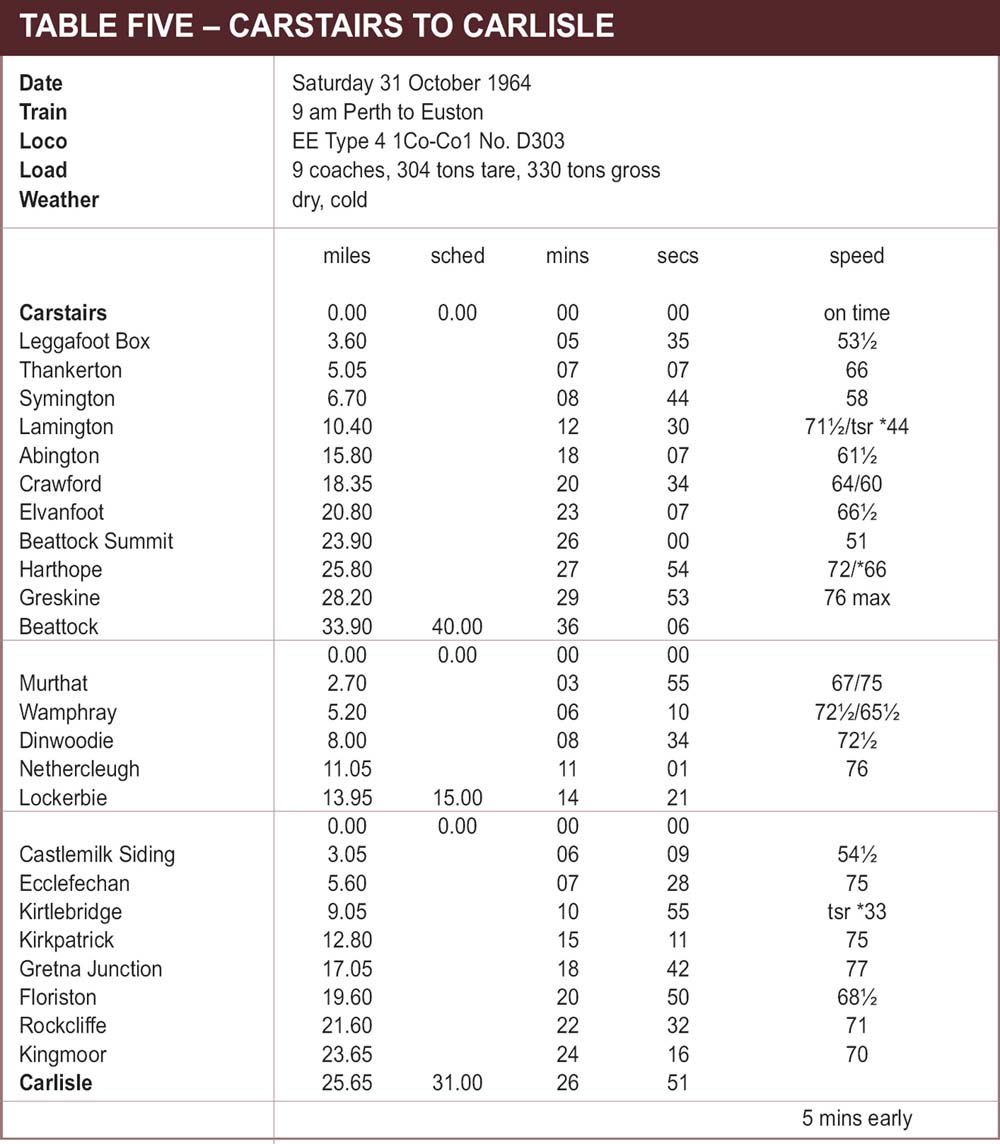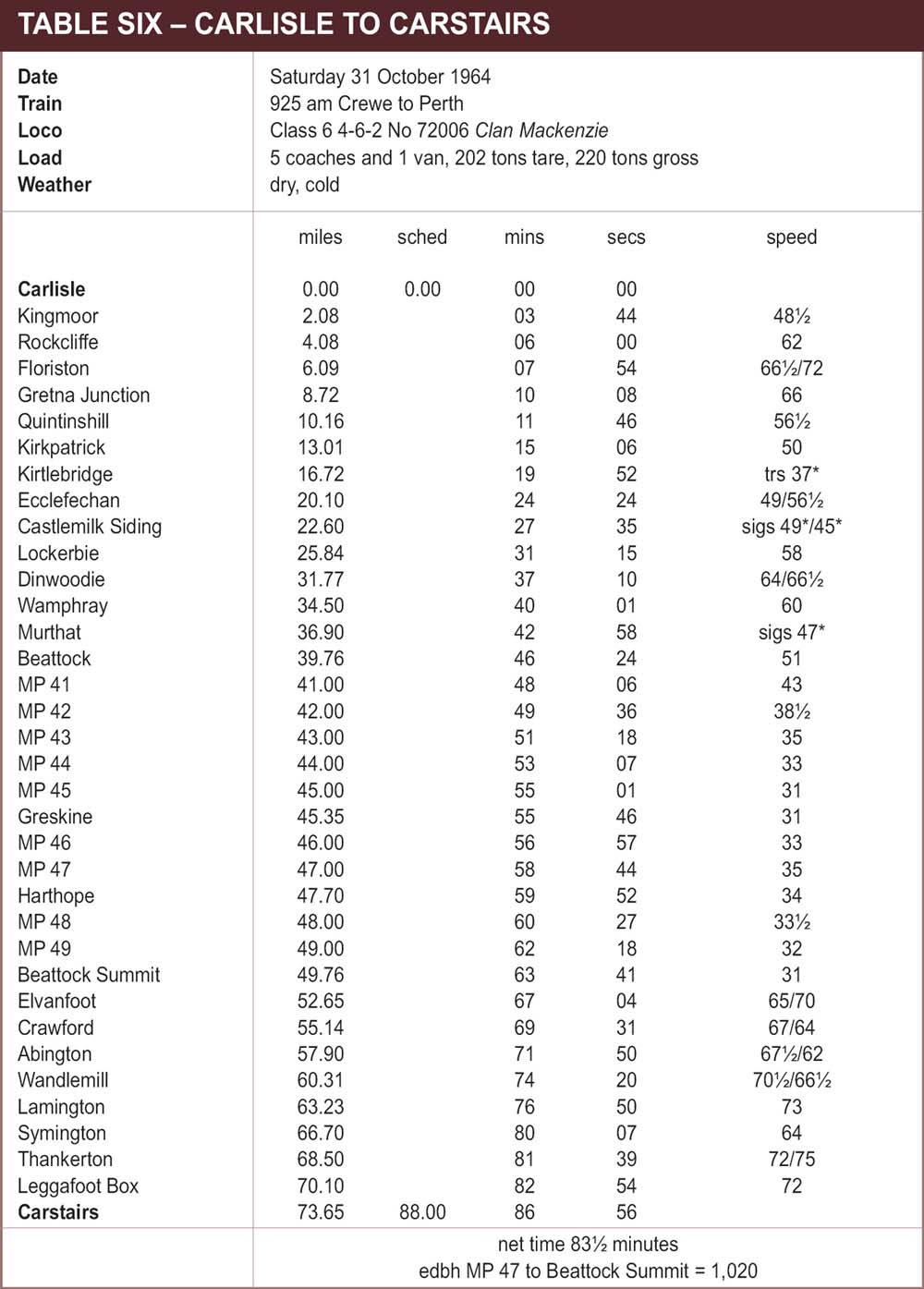

31 October 1964. 60009 Union of South Africa leaving Stirling with the 7.10 am Aberdeen to Glasgow.
“The engine was spotless and our driver as far as Perth, John Thompson, gave us a characteristically solid performance”

1 November 1964. 46160 Queen Victoria’s Rifleman on shed at Polmadie.
This was my first full trip to Scotland. I accompanied a friend from my Southern steam exploits, the very knowledgeable John Evans, who unfortunately is no longer around. Without John this unadventurous 19-year-old would not have ventured forth in such style as John not only knew the area, including the hotels, but had also secured shed passes for our Sunday shed bash. So it was that I found myself on the 7.30 pm Kings Cross to Aberdeen behind Deltic No D9010, the first of many journeys on this train. From Edinburgh we were hauled to our destination by EE type 4 No D326, reached three minutes early and in time for breakfast in the buffet. Then we joined the 7.10 am three hour train to Glasgow, six coaches hauled by one of Gresley’s splendid A4 pacifics, No 60009 Union of South Africa, which is fortunately preserved and still on the main line today. The engine was spotless and our driver as far as Perth, John Thompson, gave us a characteristically solid performance, keeping the schedule to the first stop at Stonehaven and then running the 41.65 miles to Forfar at an average speed of 60.4mph, with a maximum speed of 80mph at Laurencekirk.

30 October 1964, Stirling. 45168 on the 9.40 am Callander to Edinburgh.


On to Perth we did even better over this racing stretch, covering the 32.5 miles at a start to stop average of 65.8mph, thus gaining time on the schedule and arriving over two minutes early. The log of this section is shown in Table One. The maximum of 84mph over the river at Cargill wasn’t unusual on this train, despite the 75mph limit applying throughout Scotland. A fresh crew took us on to Stirling nicely inside schedule and here we alighted in order to return to Stonehaven on the 10.47 am train behind Type 4 No D337, to catch the 1.30 pm semi-fast train from Aberdeen, also booked for A4 haulage. There was still a profusion of steam in the area, many being Stanier Black 5s; in total that day I noted no less than thirty-one different engines in steam or working trains, including No 55204, a McIntosh 0-4-4 tank built in 1910 and withdrawn just after our visit.
Our A4 on the 1.30 pm from Aberdeen was No 60016 Silver King with a load of seven plus a van, totalling around 300 tons and this performed well, without any fireworks, to deposit us at Gleneagles four minutes early. We had just failed to achieve even time from Forfar to Coupar Angus despite a maximum speed of 77mph. There we picked up the 9.25 am Crewe to Perth semi-fast train, which we were to catch from Carlisle the next day; a train which was capable of producing almost anything as motive power. Today we had rebuilt Scot No 46160 Queen Victoria’s Rifleman on five coaches and three vans and this ran with very little effort down the hill to Perth, arriving on time. The log is shown in Table Two. Here we booked in to the North British Hotel next to the station before returning for some more steam mileage, this time on the line to Dundee.
First we caught a DMU on the 5.33 pm out to Invergowrie, returning with BR Standard Class 5 No 73150 on six coaches, then another BR Standard Caprotti Class 5 No 73152 on eight for about 285 tons which did well to keep the tight 15 minute booking to Errol providing lots of noise in the process (Table Three). Finally we returned to Perth behind Stanier Class 5 No 44718 for a meal and an early night. This engine was in immaculate ex works condition and ran into Perth three minutes early.
The next day, a Saturday, our objective was Carlisle and the aforementioned 9.25 am Crewe to Perth train which we had caught from Gleneagles the previous day. Our southbound train was to be the diesel hauled 9 am Perth to London Euston, but first we caught the 8.51 am from Perth to Stirling, which was the 7.10 am from Aberdeen, again hauled by Union of South Africa and again with the same 6-coach load. This produced a good run up the climb to Gleneagles with speed sustained at 47mph over the last mile of 1 in 101, before a carefree dash down to Dunblane with scant regard to the 75 mph limit, as shown in Table Four.

1 November 1964. B1 61099 with A4 60010 on shed at St Margarets.
At Stirling we picked up the 9 am from Perth hauled by EE Type 4 No D303 on nine coaches and this had little problem keeping the easy schedule with only marginal excesses above 75mph. The log is shown in Table Five. At Carlisle it soon became apparent that the engine for our train back to Scotland would be a BR Class 6 ‘Clan’ and so No 72006 Clan Mackenzie gave me my one and only run behind one of these unloved (and unwanted?) machines. With just five coaches and a van for 220 tons it was well up to the task with no great effort required (Table Six). We left the train at Larbert where arrival was nearly four minutes early and caught a DMU to Glasgow before booking into the Caledonian Hotel, just down from Buchanan Street station. The plan then was to catch the 5.30 pm to Perth behind another A4 Pacific but although my companion did this I decided to catch up on some lost sleep and so stayed behind. That day I recorded another thirty-five engines in steam or working trains, again mainly Stanier Class 5s. 76070, 42129 and 42214 were noted at Beattock waiting to bank northbound trains up the hill.



We were up bright and early the next day, a Sunday, as this was shed bash day. It started by catching a number 7a bus to Polmadie where thirty-five engines were on shed including No 46160 from our run on Friday, and two Class A2 Pacifics, 60524 and 60527, both then still in service. By bus back to Glasgow and then the 10.45 am from Queen Street to Falkirk Grahamston and another bus to Grangemouth shed. Here there were twenty-seven engines, many dumped including J37 0-6-0 freight locos Nos. 64580 and 64636. Grangemouth shed would close a year later. Then it was bus back to Falkirk for the 1.34 pm train to Edinburgh Haymarket and another bus to St Margarets shed, changing in Princes Street and alighting at Clockmill Road.
At St Margarets we had our only slightly hostile reception though we were allowed round. Here were quite a few express passenger engines in the form of Gresley’s A3 and A4 Pacifics plus an A1 and a number of V2s.
In total there were forty on shed mostly in steam, the biggest surprise being the large number of B1 4-6-0s, one of which, 61244, would work to Hawick the next day. It was just a pity that the drab weather which had been with us so far continued through the day and so it was beginning to get dark as we caught the number 4 bus to Waverley to get a meal. Then came the final shed visit of the day, which was to Dunfermline, gained by catching the 5.20 pm DMU from Waverley to Dunfermline Lower and then walking. Here in the pitch black we found the foreman asleep and so wandered round quietly bagging a total of eighteen, mostly in steam, including five WD 2-10-0s and two 1888 built Holmes J36 0-6-0s. After this clandestine visit John and I decided to part company as he wanted to cover the B1 turn in from Hawick the next day and I wanted another run on the 7.10 am from Aberdeen. So I caught the 7.03 pm from Dunfermline Lower to Waverley and then the 8 pm to Glasgow before boarding the 11.10 pm from Glasgow Queen Street to Aberdeen which was hauled by D5126 to Perth and A4 No 60006 Sir Ralph Wedgwood from there. Surprisingly I remember nothing of this journey or of what must have been a long and cold wait at Aberdeen after arrival at 3.05 am on Monday morning until gaining the warmth of the 7.10 am three-hour train. This was once again hauled by A4 No 60009 Union of South Africa on six coaches, turning in another faultless performance with another even time run from Stonehaven to Forfar and a time of 29 minutes 31 seconds on to Perth, an average of 66.1mph with a maximum speed of 83 over the river at Cargill.

31 October 1964. 72006 Clan Mackenzie stands at Carlisle waiting to take the 9.25 am Crewe to Perth forward.

By now I had run out of both film and money so decided to wait at Perth for the next steam hauled train to Glasgow, which was the 10 am from Dundee to Glasgow semi-fast two-hour train on very tight timings. It duly appeared running late and to my delight had Jubilee 5XP 4-6-0 No 45742 Connaught, last of the class, on nine well filled coaches for about 330 tons. It was so busy I had to stand but well worth it for the sparkling performance turned in by the Jub and her footplate crew. We were 19 minutes late away and I was treated to some superb Jubilee three cylinder roar as we stormed out of Perth and up the climb to Gleneagles. As speed dropped on the 1 in 100 so the noise increased and speed stabilised at 44mph over the last mile of the climb, which according to my calculations meant that the Jub was putting out 1,500 equivalent drawbar horsepower, a very high figure for a Class 6 engine, and my highest with a Jubilee, not even being surpassed by the efforts of Leander or Kolhapur in their later years on the main line. In fact the big effort continued throughout to Glasgow, reached 15 minutes late unchecked but with over time at all station stops due to the heavy volume of passengers. Details of the run as far as Stirling are shown in Table Seven. For me this run was the highlight of the trip and well worth the night of lost sleep. From Buchanan Street I crossed Glasgow to Queen Street and caught the 1.30 pm DMU to Waverley where, reunited with my friend we boarded the 4 pm to Kings Cross Talisman, seven coaches and four Pullmans headed by Deltic D9020 Nimbus. We enjoyed a steak meal as the Deltic whisked us south to arrive in Kings Cross just a few minutes late after some very fast running up to 105mph, and with an extra stop at Darlington and delays in the Hitchin area. So ended the first of many forays north of the border, mainly to time the Gresley Pacifics in their last days.

1 November 1964, Polmadie shed. 46160 Queen Victoria’s Rifleman with a couple of BR class 4 tanks and 73061.


1 November 1964, St Margarets Shed. 60100 Spearmint.

1 November 1964, St Margarets shed. 60010 Dominion of Canada with 60100 Spearmint, 61294 and 61099.

1 November 1964, Grangemouth shed. J37 No 64580.
